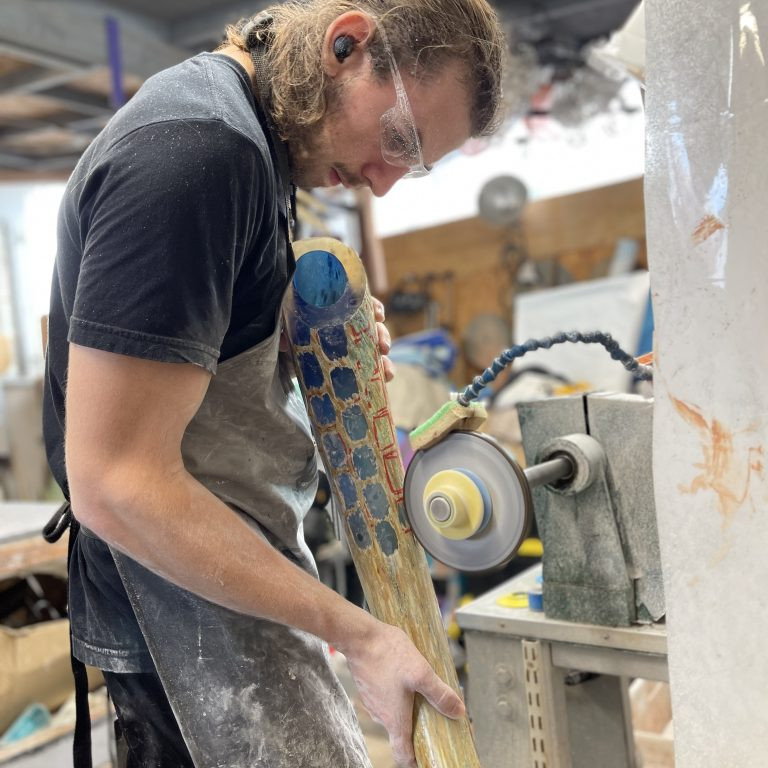Pamela Sunday Ceramic Sculptor
What, lead you to leap into ceramics full time?
I entered the world of ceramic serendipitously. A group of friends were searching for creative ways to socialize. It was the “Sex In The City” era, and we opted for creativity over cosmopolitans, I fell in love with the material of clay and the process of blending it to my will. It was challenging and scary to leave behind a successful life in fashion, but my passion for clay won out. I was fortunate to have design magazines to take notice of the work early on.
Now looking back on this move what have been two highlights?

One major highlight was a commission from Francois Catroux, the legendary Paris based designer. I was challenged to make a group of huge iterations of my Electrum Series. It was necessary to balance the new scale with the delicacy of the points. I spent many months experimenting and relearning the form, discovering how to make it work on a larger scale.
Another highlight was a feature in German Vogue. They ran a full-page portrait with my work and lovely interview, resulting in a whole new level of exposure to European collectors.
Many artists have been propelled by time at Anderson Ranch Arts Centre – how did your time there nourish you and your work?
I took a workshop at Anderson Ranch in the mid – 1990’s with the renowned Tony Hepburn. The experience of total immersion there, in a group of obsessed cohorts and teachers, was the impetus for setting up my first studio. The envoromnent gave me permission to consider myself an artist and make a full – on commitment to my future.
Discuss the importance of excellent photography of each piece.
Relate this back to your time as an Art Director and Artist.
I spent a decade working in the advertising department of Bergdorf Goodman. My aesthetic and work ethic developed there.
My husband, Paul Sunday, photographs most of my work. He is known for his beautiful lighting (and patience!). I was lucky to have publication – ready images from the beginning of my career.
How is nature and science represented in your work?
I take inspiration from the images of microscopic life, scientific illustrations, historical references, and photography. The endless permutations and possibilities afforded by the recurrence of the orb in nature will no doubt continue to sustain my interest!
 MOLECULAR: 19” high x 15” wide/deep: glazed stoneware
MOLECULAR: 19” high x 15” wide/deep: glazed stoneware
Please discuss the technique you use to make your work.
My sculptures are made by joining repetitive elements. Some components are formed on the wheel, and others are made using an assortment of hand-building techniques. I have a habit of pushing the tolerance of my materials to the edge. Each piece takes many weeks to complete. My process is an exercise in endurance and tenacity.

HIVE: 15”x 15”x 15”. Unglazed brown stoneware with lustre in indents
Discuss the importance of prominent pieces in an architectural setting.
When a sculpture can attain presence in an architecturally significant space, both are transformed into something more thrilling and memorable.
What size limits do you have?
There are no limits. Things keep getting bigger, it would be fun to see where I can go next.
Does all, of your work have a metallic lustre?

SAEPIO: 24” long x 19” wide x 12.5” high. Glazed stoneware
I love glaze chemistry; it’s a big part of the fun for me. I will always be developing new surfaces. While I have often gravitated toward metallic glazes, lately, I have been exploring rich glossy blacks and reds. My early work was often matte and textural. For me, it’s about pairing the form with the appropriate surface.

MOTUS: 19” long x 16” wide x 11.5” high. Glazed stoneware
Shape is a huge aspect of your work – take two or three pieces and expand on your use of sharp and soft shapes.
Stella:
Every aspect of this form is planned, the central sphere, three sizes of attachments, and the placement / balance of each component. I hope that it looks organized and organic at the same time.

STELLA: 14”X 14”x 14”, stoneware with satin metallic glaze
Rubrum:
This piece explores a new direction, exploiting a generative strategy, and asymmetry. It’s a different way of working but the orb is still the foundation.

RUBRUM: 24” long x 13” wide x 9.5” high. Glazed stoneware
Do you ever have work sold in series or collections?
Yes, on occasion, collectors have commissioned pairs or groups of works. The new generative experiments could lead to more of this way of thinking. The possibilities for groupings, series, and installations are endless.
Contact:
Pamela Sunday
Pamelasunday.com
Deborah Blakeley, Melbourne, Australia
Interview by Deborah Blakeley, February 2020
Think a colleague or friend could benefit from this interview?
Knowledge is one of the biggest assets in any business. So why not forward this on to your friends and colleagues so they too can start taking advantage of the insightful information the artist has given?
Other artists you may be interested in:






